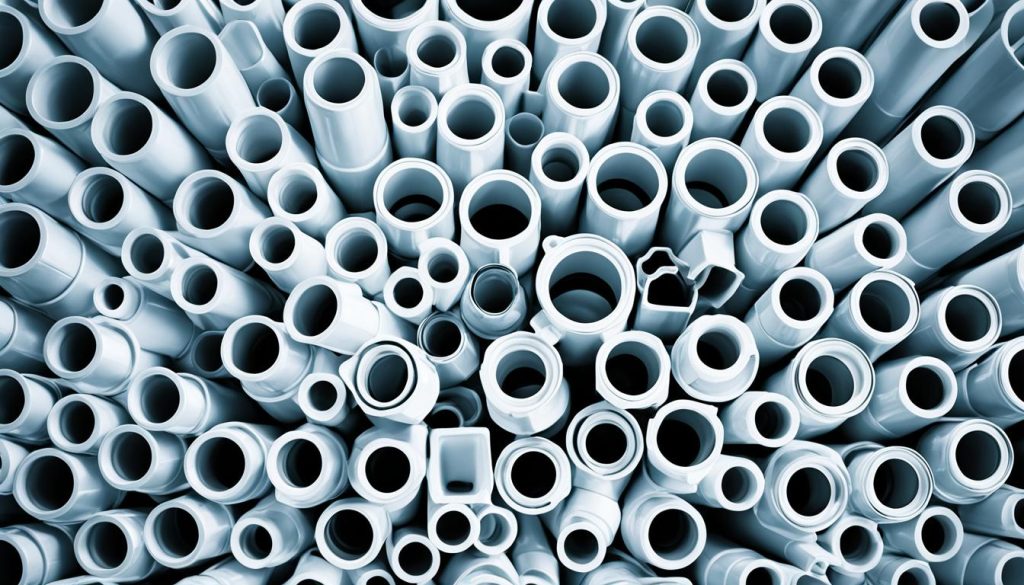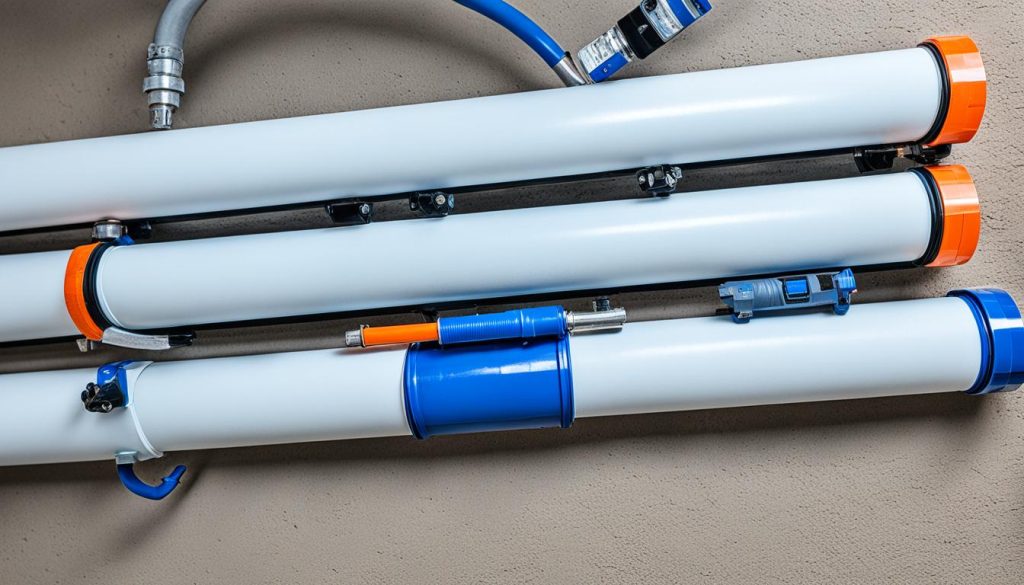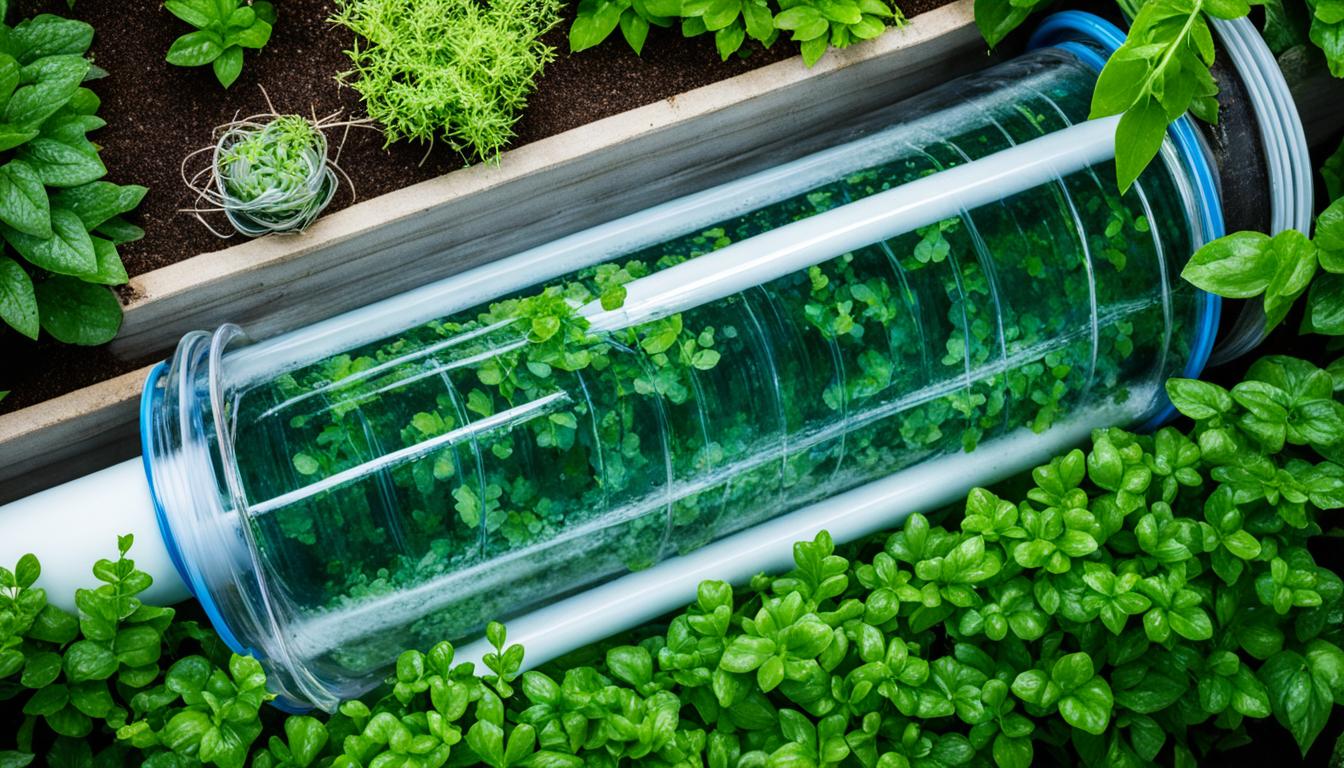Did you know that PVC pipes are used in a wide range of applications, from plumbing systems to electrical conduits? These versatile pipes have become a staple in the construction industry, offering numerous benefits and advantages. Whether you’re a DIY enthusiast or a professional plumber, understanding the ins and outs of PVC pipes is essential. In this quick guide, I will take you through the world of PVC pipes, exploring their definition, uses, sizes, materials, installation methods, and more. Get ready to dive into the fascinating world of PVC pipes!
Key Takeaways:
- PVC pipes are commonly used in plumbing systems and electrical conduits.
- They offer a range of benefits, including durability, resistance to corrosion, and easy installation.
- PVC pipes come in various sizes and can be joined using fittings to create customized plumbing systems.
- Proper sizing and compatibility are crucial for secure connections.
- Installation methods include solvent cement welding, push-fit style fittings, and threaded connections.
PVC Pipe Sizes and Compatibility
When it comes to PVC pipes and fittings, understanding their sizes and compatibility is crucial for a successful plumbing project. PVC pipes and fittings use a nominal system for standard sizing, meaning that parts with the same size in their name will be compatible with each other.
However, it’s important to note that the outer diameter (OD) of PVC pipes is greater than the size in their name. For example, a 1″ PVC pipe will have an OD that is greater than 1″, and a 1″ PVC fitting will have an even larger OD than the pipe.
The most important factor to consider when working with PVC pipes and fittings is the nominal size. As long as a fitting and a pipe have the same nominal size, they will be compatible with each other, regardless of whether they are schedule 40 or schedule 80.
It’s essential to ensure compatibility when using PVC fittings with non-PVC pipes. In these cases, the OD of the pipe should match the ID of the fitting for a secure connection.
PVC Pipe Sizes
PVC pipes are available in various sizes to accommodate different plumbing needs. The sizes are standardized and do not directly correlate to their actual dimensions. Here is a table showcasing some common PVC pipe sizes:
| PVC pipe size (nominal size) | Outer Diameter (OD) | Minimum Wall Thickness | Average Inside Diameter (ID) |
|---|---|---|---|
| 1/2″ | 0.840″ | 0.109″ | 0.622″ |
| 3/4″ | 1.050″ | 0.113″ | 0.824″ |
| 1″ | 1.315″ | 0.133″ | 1.049″ |
| 1-1/2″ | 1.900″ | 0.145″ | 1.610″ |
| 2″ | 2.375″ | 0.154″ | 2.067″ |
Table: Common PVC pipe sizes
These sizes are just a sample of the available options. It’s important to refer to a PVC pipe sizing chart for accurate information on each specific size.
By understanding PVC pipe sizes and ensuring compatibility between pipes and fittings, you can confidently tackle your plumbing projects and create secure connections.
PVC Pipe Materials and Benefits
When it comes to plumbing, PVC pipes are a popular choice due to their exceptional qualities. PVC pipes are made from a thermoplastic material called polyvinyl chloride, known for its durability and versatility.
One of the significant benefits of PVC pipes is their resistance to corrosion, chemicals, and alkalis. This makes them perfect for various plumbing applications, ensuring long-lasting performance and reliability.
Lightweight and Easy to Handle
PVC pipes are incredibly lightweight compared to other pipe materials, such as metal or concrete. This makes them easy to handle and install, reducing the time and effort required for plumbing projects. Additionally, the lightweight nature of PVC pipes allows for more flexibility during installation, making them suitable for various plumbing configurations and layouts.
Low Thermal Conductivity
PVC pipes have low thermal conductivity, meaning they do not transfer heat as easily as other materials. This property is particularly beneficial in areas where freezing temperatures are a concern. PVC pipes help reduce the likelihood of freezing and maintain water temperatures, ensuring a steady and efficient flow of water throughout the plumbing system.
Smooth Interior Surface for Efficient Water Flow
The smooth interior surface of PVC pipes promotes efficient water flow. The absence of rough edges or irregularities minimizes friction, allowing water to move smoothly through the pipes. This translates to improved water pressure and reduced energy consumption, resulting in cost savings and optimized plumbing system performance.
Durable and Long-Lasting
PVC pipes are known for their durability and long lifespan. They are resistant to wear and tear, ensuring they can withstand the rigors of daily use and environmental factors. PVC pipes are not prone to rust or corrosion, making them an excellent choice for both indoor and outdoor plumbing applications. Their longevity makes PVC pipes a cost-effective solution, as they require less maintenance and replacement over time.
| Benefits of PVC Pipes |
|---|
| Resistance to corrosion, chemicals, and alkalis |
| Lightweight and easy to handle |
| Low thermal conductivity, reducing the likelihood of freezing |
| Smooth interior surface for efficient water flow |
| Durable and long-lasting |
PVC Pipe Fittings and Their Applications
PVC pipe fittings play a crucial role in plumbing systems, offering versatility and reliability. These fittings come in various types, each designed to serve a specific purpose. Understanding the different types of PVC fittings can help you create efficient and customized plumbing systems.
Tees
Tees are commonly used in plumbing systems to connect three pipes at right angles. They allow for the efficient distribution of water or other fluids. Tees are available in different sizes and are essential for creating complex plumbing configurations.
Elbows
Elbows are used to change the direction of a pipeline. PVC elbows are available in 90-degree and 45-degree angles, allowing for smooth turns and redirects in plumbing systems. They are ideal for navigating around corners or obstacles.
Crosses
Cross fittings are used to join four pipe sections at 90-degree angles. They provide structural integrity to frameworks, such as in sprinkler systems or irrigation setups. Crosses ensure a sturdy and reliable connection between pipes.
Couplings
Couplings are used to connect pipe to pipe or pipe to fitting. They enable seamless transitions and secure connections between different components of a plumbing system. Couplings are available in various sizes, accommodating different pipe diameters.
Caps and Plugs
Caps and plugs are used to stop the flow of water in a plumbing system. Caps are used to seal the end of a pipe, while plugs are inserted into a fitting to prevent water leakage. These fittings are essential for maintenance or when certain sections of the system need to be temporarily closed off.
Adapters
Adapters allow for the change of end types of a pipe. They are used when transitioning between different pipe materials or sizes. Adapters ensure a secure and leak-free connection between pipes that may have different specifications.
Bushings
Bushings are used to connect pipes of different diameters. They serve as reducing fittings, allowing for a smooth transition between pipes with different sizes. Bushings provide stability and ensure a tight seal between the connected pipes.
Nipples
Nipples are used to connect two female ends in a PVC system. These fittings are commonly used in plumbing systems to extend or repair pipe sections. Nipples provide a reliable connection between different components, ensuring efficient water flow.
Flanges
Flanges are used to attach accessories, such as valves or fixtures, to a PVC pipe. They provide a secure joint and increase the strength of the pipe. Flanges are essential for connecting components that require stability and durability.
By understanding the different types of PVC pipe fittings and their applications, you can create versatile and efficient plumbing systems. These fittings allow for customization, adaptability, and secure connections, ensuring the smooth operation of your plumbing system.

PVC Pipe Installation and Connection Methods
When it comes to installing PVC pipes, there are several methods to consider. Each method offers its own advantages and is suitable for different applications. Here, I will discuss three popular PVC pipe installation and connection methods: solvent cement welding, push-fit style fittings, and threaded connections.
Solvent Cement Welding
One of the most common methods for joining PVC pipes is through solvent cement welding. This process involves using PVC primer and cement to create a strong chemical bond between the fitting and pipe surfaces. The solvent cement softens the surfaces, allowing them to fuse together and form a leak-proof seal.
To use solvent cement welding, follow these steps:
- Prepare the pipe and fitting surfaces by cleaning them with PVC primer.
- Apply a generous amount of PVC cement to both the pipe and fitting.
- Quickly join the pipe and fitting, giving them a quarter-turn to evenly distribute the cement.
- Hold the pipe and fitting in place for about 15 seconds to allow the cement to dry and create a strong bond.
Solvent cement welding provides a reliable and durable connection, making it suitable for both residential and commercial plumbing systems.
Push-Fit Style Fittings
Push-fit style fittings, such as PVC-Lock fittings, offer a convenient and tool-free installation process. These fittings have pre-installed rubber gaskets that create a tight seal when the pipe is pushed into the fitting. This allows for easy installation, removal, and reusability.
The push-fit installation method is as follows:
- Cut the pipe to the desired length using pipe cutters or saws.
- Remove any burrs from the cut end of the pipe for a smooth surface.
- Insert the pipe into the push-fit fitting until it reaches the depth mark.
- Ensure the pipe is securely in place by giving it a slight tug.
Push-fit style fittings are a great option for DIY projects or situations where a temporary connection is required.
Threaded Connections
Threaded connections are another method used for PVC pipe installation, especially when pipes may need to be easily taken apart or adjusted. These connections require the use of thread seal tape to ensure a sealed and lubricated joint.
Here’s how to create a threaded connection:
- Wrap thread seal tape clockwise around the male end of the pipe.
- Hand-tighten the threaded female fitting onto the taped pipe end.
- Secure the connection using pipe wrenches, ensuring a tight and leak-free seal.
Threaded connections are commonly used in applications where frequent disassembly and reassembly may be required, such as irrigation systems.
Proper installation techniques and following manufacturer recommendations are essential for creating secure and leak-proof connections in PVC pipe systems. Whether you choose solvent cement welding, push-fit style fittings, or threaded connections, it’s important to select the method that best suits your specific plumbing needs.
| Installation Method | Advantages | Disadvantages |
|---|---|---|
| Solvent Cement Welding | Creates a strong and leak-proof bond; suitable for permanent connections | Requires the use of primer and cement; not easily disassembled |
| Push-Fit Style Fittings | Quick and tool-free installation; easy removal and reusability | May require additional support depending on the application; not suitable for high-pressure systems |
| Threaded Connections | Easily adjustable and disassembled; suitable for temporary connections | Requires the use of thread seal tape; potential for leaks if not properly sealed |

The Importance of Proper PVC Pipe Sizing
Proper PVC pipe sizing is crucial for the optimal functioning of plumbing systems. PVC pipes are sized based on their nominal size, which refers to the inside diameter (ID) of the pipe. It’s important to note that the nominal size of a pipe may not correspond to its actual measurements. Pipe sizes follow standardized dimensions and do not directly correlate to their physical measurements. Therefore, relying solely on the nominal size may lead to incorrect choices for fittings and pipes.
To ensure accurate PVC pipe sizing, it is essential to consult a PVC pipe sizing chart. This chart provides comprehensive information such as the nominal size, outside diameter (OD), minimum wall thickness, and average inside diameter (ID) for each pipe size. By referring to the PVC pipe sizing chart, you can determine the appropriate size of fittings and pipes for your specific plumbing needs.
Understanding and implementing proper PVC pipe sizing is vital for successful installation and optimal system performance. Accurate sizing ensures a secure and leak-free connection between pipes and fittings, minimizing the risk of plumbing issues in the future.
By adhering to the recommended PVC pipe sizing guidelines, you can ensure that your plumbing system functions efficiently and effectively. Whether you are working on a residential or commercial project, taking the time to select the right pipe size is a crucial step in achieving reliable and durable plumbing installations.
Tips for Connecting PVC Pipe and Fittings
When it comes to connecting PVC pipes and fittings, there are a few essential tips that can help ensure a successful and secure joint. The first step is to make square cuts on the pipes using pipe cutters or saws, ensuring a proper fit between the pipes and fittings. After cutting, it’s important to sand off any burrs to create a smooth surface.
Prior to assembly, it’s crucial to orient and mark the pipes and fittings to ensure proper alignment. To create a strong bond, the next step is to apply PVC primer on the inner surface of the fitting and the outer surface of the pipe. This creates a bonding surface that promotes adhesion and enhances the strength of the joint.
Once the primer has been applied, evenly apply PVC cement to both the fitting and the pipe. Insert the pipe quickly into the fitting, making a quarter-turn to spread the cement and ensure an even distribution. To allow the cement to bond effectively, hold the pipe and fitting together firmly for approximately 15 seconds.
Following these simple yet crucial tips will help you achieve strong and leak-free connections in your PVC pipe systems. Properly connecting PVC pipe and fittings using PVC cement and primer is essential for the overall performance and durability of your plumbing system.
Source Links
- https://help.dripdepot.com/support/solutions/articles/11000062020-pvc-buying-guide
- https://www.pvcfittingsonline.com/resource-center/pipe-fittings-sizes-guide/
- https://www.tigerfishtools.com/news/the-ultimate-guide-to-preparing-and-using-all-types-of-pvc-pipe-fittings/
